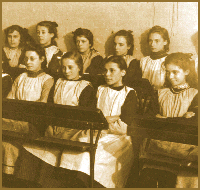
Education in Wales 5
1870-1902
Universal education established
In 1876 the principle was established that all children
should receive an elementary education, and parents were to be
liable for the attendance of their children. The Education Act,
1876 also recommended setting up school attendance committees
to enforce more regular attendance. By the Education Act, 1880,
school attendance to the age of ten was made compulsory. Children
could leave school at ten, but could also be required to stay
on if their attendance had not been satisfactory.
The appearance of county councils in 1889 heralded the next development in education in Wales. The Welsh Intermediate Education Act of 1889 established county joint education committees, the majority of whose members were to be councillors. (The act was a private measure by Stuart Rendel, Liberal M.P. for Montgomeryshire 1880-1894 and a close personal friend of Gladstone.) The joint committees were to draw up plans for county schools (later grammar schools) to be financed from a combination of the rates, a treasury grant, fees from pupils and the reorganization of old endowments. (see John Beddoes' School).This was the first time that public money was spent on specifically Welsh intermediate education, and it provided education supported by the rates earlier than in England. Many of the old, endowed schools chose to be part of the new system but others - including Brecon - remained outside. In matters relating to examinations and inspections they were answerable to the Central Welsh Board, established in 1896.
Local Education Authorities
 On
1 September 1891 elementary education became free of charge.
In 1893 the school leaving age was raised to eleven, and in 1899
it was raised again to twelve. Under Balfour's Education Act,
1902, School Boards were abolished and Local Education Authorities
were established. The Education Committees of county councils
were made responsible for elementary and intermediate schools
(the act called Church schools Non Provided schools and called
Board schools Provided schools). But the measure was intended
in part by the Conservative government to safeguard the future
of the Church schools, which had received no funding from the
rates (unlike the Board schools since 1870). The Nonconformists
had hoped that the Church schools would gradually disappear for
lack of funds, but now they would receive funding from the rates
too - and since Church schools were often the only ones available
in an area it meant that Nonconformist children would have to
continue to attend Anglican schools.
On
1 September 1891 elementary education became free of charge.
In 1893 the school leaving age was raised to eleven, and in 1899
it was raised again to twelve. Under Balfour's Education Act,
1902, School Boards were abolished and Local Education Authorities
were established. The Education Committees of county councils
were made responsible for elementary and intermediate schools
(the act called Church schools Non Provided schools and called
Board schools Provided schools). But the measure was intended
in part by the Conservative government to safeguard the future
of the Church schools, which had received no funding from the
rates (unlike the Board schools since 1870). The Nonconformists
had hoped that the Church schools would gradually disappear for
lack of funds, but now they would receive funding from the rates
too - and since Church schools were often the only ones available
in an area it meant that Nonconformist children would have to
continue to attend Anglican schools.
There are 6 pages on the origins of education in Wales. Use the box links below to view the other pages.